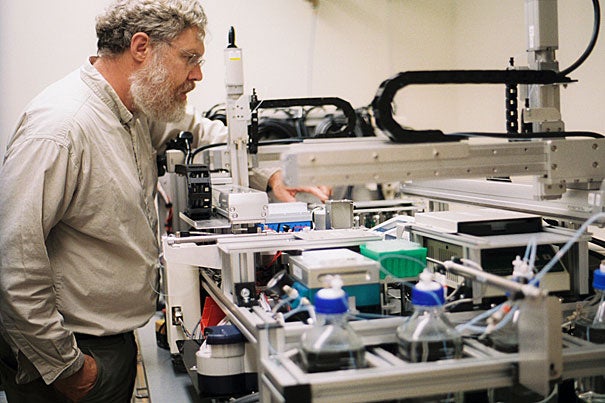
The power to edit genes, according to Harvard Medical School Professor George Church, adds functionality to a cell by encoding for useful new amino acids, introduces safeguards that prevent cross-contamination between modified organisms and the wild, and establishes multiviral resistance by rewriting code hijacked by viruses.
Photo by Marie Wu
Editing the genome
Scientists unveil new tools for rewriting the code of life
The power to edit genes is as revolutionary, immediately useful, and unlimited in its potential as was Johannes Gutenberg’s printing press. And like Gutenberg’s invention, most DNA editing tools are slow, expensive, and hard to use — a brilliant technology in its infancy. Now, Harvard researchers developing genome-scale editing tools as fast and easy as word processing have rewritten the genome of living cells using the genetic equivalent of search and replace — and combined those rewrites in novel cell strains, strikingly different from their forebears.
“The payoff doesn’t really come from making a copy of something that already exists,” said George Church, a professor of genetics at Harvard Medical School who led the research effort in collaboration with Joe Jacobson, an associate professor at the Media Lab at the Massachusetts Institute of Technology. “You have to change it — functionally and radically.”
Such change, Church said, serves three goals. The first is to add functionality to a cell by encoding for useful new amino acids. The second is to introduce safeguards that prevent cross-contamination between modified organisms and the wild. A third, related aim, is to establish multiviral resistance by rewriting code hijacked by viruses. In industries that cultivate bacteria, including pharmaceuticals and energy, such viruses affect up to 20 percent of cultures. A notable example afflicted the biotech company Genzyme, where estimates of losses due to viral contamination range from a few hundred million dollars to more than $1 billion.
In a paper scheduled for publication July 15 in Science, the researchers describe how they replaced instances of a codon — a DNA “word” of three nucleotide letters — in 32 strains of E. coli, and then coaxed those partially edited strains along an evolutionary path toward a single cell line in which all 314 instances of the codon had been replaced.
That many edits surpasses current methods by two orders of magnitude, said Harris Wang, a research fellow in Church’s lab at the Wyss Institute for Biologically Inspired Engineering who shares lead-author credit on the paper with Farren Isaacs, an assistant professor of molecular, cellular, and developmental biology at Yale University and a former Harvard research fellow, and Peter Carr, a research scientist at the MIT Media Lab.
In the genetic code, most codons specify an amino acid, a protein building block. But a few codons tell the cell when to stop adding amino acids to a protein chain, and it was one of these “stop” codons that the Harvard researchers targeted. With just 314 occurrences, the TAG stop codon is the rarest word in the E. coli genome, making it a prime target for replacement. Using a platform called multiplex automated genome engineering, or MAGE, the team replaced instances of the TAG codon with another stop codon, TAA, in living E. coli cells. (Unveiled by the team in 2009, the MAGE process has been called an evolution machine for its ability to accelerate targeted genetic change in living cells.)
While MAGE, a small-scale engineering process, yielded cells in which TAA codons replaced some but not all TAG codons, the team constructed 32 strains that, taken together, included every possible TAA replacement. Then, using bacteria’s innate ability to trade genes through a process called conjugation, the researchers induced the cells to transfer genes containing TAA codons at increasingly larger scales. The new method, called conjugative assembly genome engineering, or CAGE, resembles a playoff bracket — a hierarchy that winnows 16 pairs to eight to four to two to one — with each round’s winner possessing more TAA codons and fewer TAG, explains Isaacs, who invokes “March Madness.”
“We’re testing decades-old theories on the conservation of the genetic code,” Isaacs said. “And we’re showing on a genomewide scale that we’re able to make these changes.”
Eager to share their enabling technology, the team published their results as CAGE reached the semifinal round. Results suggested that the final four strains were healthy, even as the team assembled four groups of 80 engineered alterations into stretches of the chromosome surpassing 1 million DNA base pairs. “We encountered a great deal of skepticism early on that we could make so many changes and preserve the health of these cells,” Carr said. “But that’s what we’ve seen.”
The researchers are confident that they will create a single strain in which TAG codons are completely eliminated. The next step, they say, is to delete the cell’s machinery that reads the TAG gene — freeing up the codon for a completely new purpose, such as encoding a novel amino acid.
“We’re trying to challenge people,” Wang said, “to think about the genome as something that’s highly malleable, highly editable.”
This research was funded by U.S. Department of Energy and the National Science Foundation.




